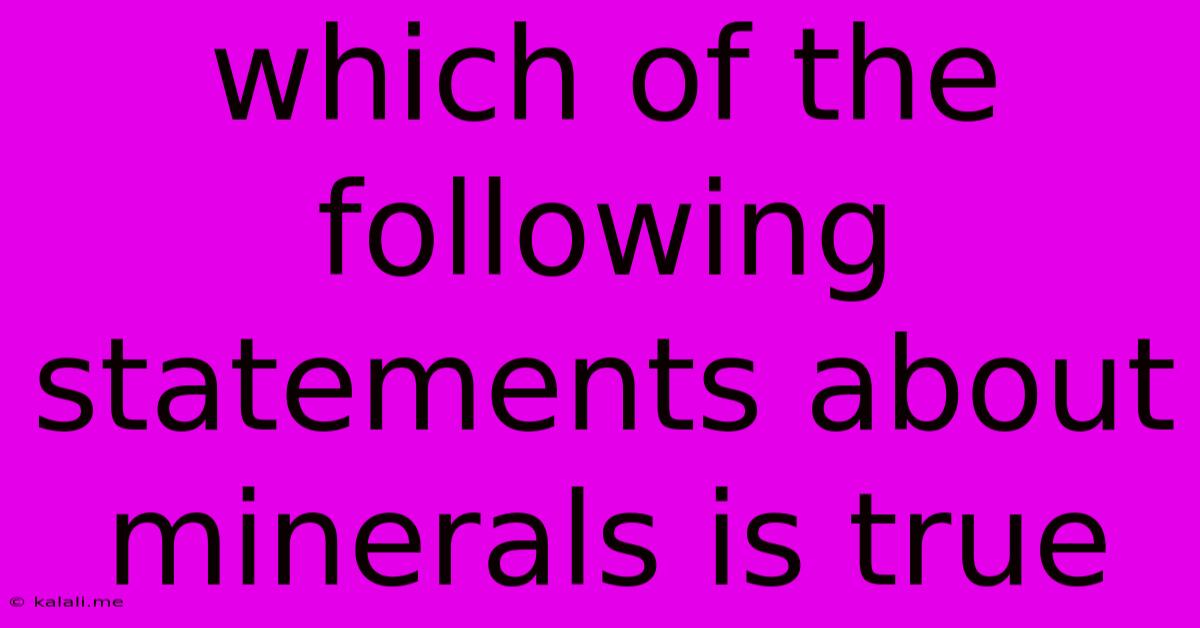Which Of The Following Statements About Minerals Is True
Kalali
Jun 13, 2025 · 3 min read

Table of Contents
Which of the Following Statements About Minerals is True? A Deep Dive into Mineral Properties
Minerals are the fundamental building blocks of rocks, forming the very foundation of our planet's geology. Understanding their properties is crucial in various fields, from geology and mining to material science and even medicine. This article explores the key characteristics of minerals and helps determine which statements about them are true. We'll delve into the intricacies of mineral formation, composition, and identification, clarifying common misconceptions.
What Defines a Mineral?
Before we evaluate statements about minerals, let's establish the criteria that define a substance as a mineral. A mineral must meet the following five criteria:
- Naturally Occurring: It must be formed by natural geological processes, not synthetically created in a lab.
- Inorganic: It must not be derived from living organisms or their remains. Coal, for example, is organic and therefore not a mineral.
- Solid: It must exist in a solid state at standard temperature and pressure.
- Ordered Atomic Arrangement: Its atoms must be arranged in a highly ordered, repeating three-dimensional pattern, forming a crystal lattice.
- Definite Chemical Composition: While there can be some variation, it must have a relatively fixed chemical formula.
Evaluating Statements About Minerals
Now, let's analyze potential statements about minerals and determine their validity based on the above definition. Without knowing the specific statements, we can cover common true and false statements related to mineral properties:
True Statements:
-
Minerals have a definite chemical composition: This statement aligns directly with the fifth defining characteristic of a mineral. While some substitution of elements can occur within the crystal lattice (resulting in variations of a mineral species), the overall chemical formula remains consistent. For example, the chemical formula for quartz is SiO₂, and while trace impurities can be present, the fundamental structure remains consistent.
-
Minerals are naturally occurring inorganic solids: This combines the first, second, and third defining characteristics. Minerals form through geological processes, are not formed from living organisms, and are solid at standard conditions.
-
Many minerals exhibit crystalline structure: The ordered atomic arrangement (point 4) leads to the external expression of crystal faces. While weathering or rapid cooling can prevent the formation of well-formed crystals, the internal atomic arrangement still adheres to the crystalline structure.
-
Minerals can be identified by their physical properties: Several physical properties, like hardness (Mohs Hardness Scale), cleavage, luster, color, streak, and specific gravity, help geologists and mineral enthusiasts identify different minerals. These properties are directly related to the mineral's chemical composition and crystal structure.
False Statements (Examples):
-
All minerals are valuable gemstones: This is false. Many minerals are commonplace and have little economic value, though they may still be geologically significant. Gemstones are a relatively small subset of minerals with specific aesthetic qualities.
-
Minerals are always colorful: Many minerals are colorless or appear in muted earth tones. Color is not a reliable identifier on its own, as impurities can significantly alter a mineral's color.
-
Minerals are easily soluble in water: The vast majority of minerals are insoluble in water. Some minerals, like halite (table salt), are readily soluble, but this is exceptional.
-
All minerals are opaque: Many minerals are transparent or translucent. The ability of a mineral to transmit light depends on its crystal structure and chemical composition.
By understanding the fundamental properties of minerals, we can accurately assess the validity of various statements. Remember to always refer back to the defining characteristics: naturally occurring, inorganic, solid, ordered atomic arrangement, and definite chemical composition. This framework will help you evaluate any statement about minerals and confidently determine its truthfulness.
Latest Posts
Latest Posts
-
What Is The Prime Factorization For 135
Jun 14, 2025
-
A Push Or A Pull Is Called
Jun 14, 2025
-
The Mass Per Unit Volume Of A Substance
Jun 14, 2025
-
A Price Ceiling Set Below The Equilibrium Price Will
Jun 14, 2025
-
Two Elements That Are Liquid At Room Temperature
Jun 14, 2025
Related Post
Thank you for visiting our website which covers about Which Of The Following Statements About Minerals Is True . We hope the information provided has been useful to you. Feel free to contact us if you have any questions or need further assistance. See you next time and don't miss to bookmark.